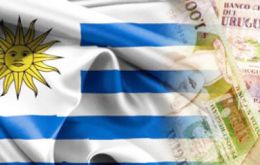MercoPress. South Atlantic News Agency
Tag: Uruguay's GDP
-
Wednesday, June 4th 2014 - 09:03 UTC
Timid S&P ignores Moody's and leaves Uruguay' risk rating unchanged

Standard & Poor's (S&P) decided on Tuesday to maintain Uruguay's sovereign debt risk rating unchanged at the lowest investment grade BBB-, because although it has solid growth prospects, predictable policies and a favorable debt profile, the country still has limited fiscal and monetary flexibility and lives in a neighborhood experimenting 'economic stress'.
-
Thursday, March 28th 2013 - 10:03 UTC
Uruguay 2012 GDP expanded 3.9% boosted by construction and domestic demand

Uruguay’s GDP expanded 3.9% last in 2012 over the previous year despite a slight contraction in the fourth quarter, according to a late Wednesday release from the Central bank. The bank’s original estimate was 4%. In 2011 the economy grew a revised 6.5%.
-
Saturday, December 29th 2012 - 04:07 UTC
Uruguay raises basic rate to 9.25%: “inflation the key risk of the economy”

Uruguay’s Central bank raised its benchmark interest rate on Friday for the second time this year as policy makers struggle to bring inflation into the government’s target range. The IMF and local economists have warned about the need to “tackle inflation”, particularly since the budget’s fiscal deficit has soared in just twelve months from 0.4% of GDP to over 3% of GDP.
-
Friday, December 14th 2012 - 20:35 UTC
“Tackling inflation”, Uruguay’s top priority says IMF and suggests government cuts spending

“Tackling inflation is Uruguay’s priority” said the International Monetary Fund board on Friday after inflation in October climbed to 9.1%. Monetary policy is not enough: the government must make efforts to cut back government spending and moderating wage growth insisted the IMF.
-
Friday, December 14th 2012 - 07:42 UTC
Uruguayan economy expands 3% in third quarter boosted by construction of pulp mill

Uruguay’s economy grew faster than economists expected in the third quarter, spurred by increased construction, transportation and communications activity. GDP expanded 3% from a year earlier, the central bank said on Thursday on its website. The economy grew 1.2 percent from the second quarter, the bank said.
-
Friday, November 23rd 2012 - 23:20 UTC
Mujica calls for prudence with salaries: “look at what is happening on the other side (Argentina)”

Uruguayan president Jose Mujica appealed to workers and entrepreneurs to avoid an escalation of salaries and prices which leads “to all sort of fiddling” as is happening in Argentina.
-
Friday, November 2nd 2012 - 06:33 UTC
Uruguayan central bank indicator shows inflation is close to 11% in 12 months

Uruguay’s central bank said that consumer prices, excluding the most volatile items, have increased almost 11% in the last twelve months to September. Fresh fruit and vegetables, cigarettes and public utility rates are considered ‘volatile prices’.
-
Wednesday, October 24th 2012 - 21:17 UTC
Panama and Uruguay with greatest per capita GDP increase in 2008/2012, says Latinvex

Panama was the country with the greatest increase in per capita GDP in the last five years, followed by Uruguay, Peru, Dominican Republic and Chile according to a report from the digital publication Latinvex.
-
Thursday, September 15th 2011 - 07:14 UTC
Uruguay’s GDP expands 4.8% in second quarter buoyed by domestic demand

Uruguay’s GDP expanded 4.8% in the second quarter from a year earlier, the central bank said Wednesday on its website.
-
Sunday, June 19th 2011 - 10:13 UTC
Uruguay private consumption expanding several points higher than GDP

The Uruguayan economy expanded 2.3% in January-March over the previous quarter, which has elevated forecasts for the twelve months of 2011 to a floor of 6.5%. However the Uruguayan government is concerned that consumption again expanded at a higher rate than GDP.
